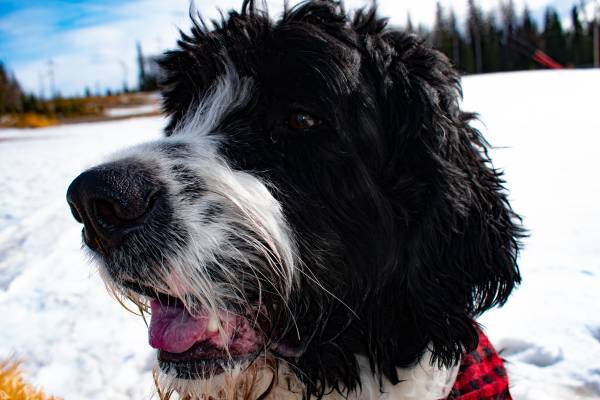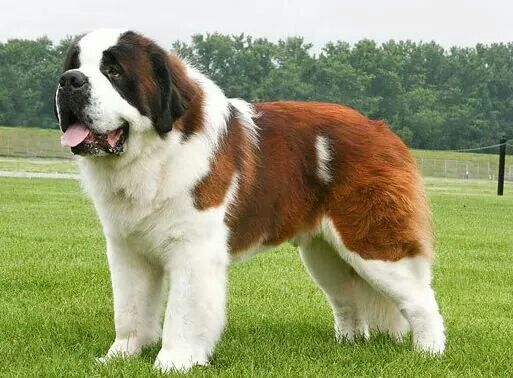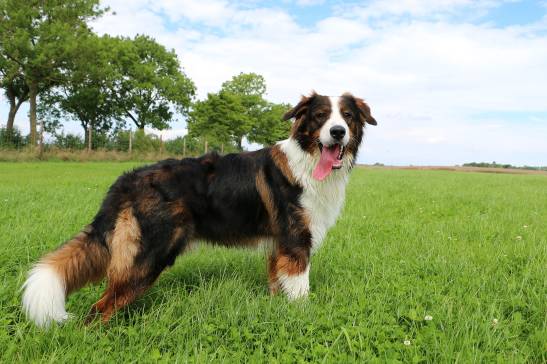Connect with a verified veterinarian in minutes. Licensed vets are available 24/7 to answer your questions. No need to worry about your furry family member.
Many people love Saint Bernards and Poodles! But what would happen if you created a mix of these two dog breeds? The result would be the Saint Berdoodle!
If you love large dogs, Saint Bernards, and Poodles, then you may want to consider adopting a Saint Berdoodle.
We’ve put together some information together on what you need to know before adopting a Saint Berdoodle. Let’s get started!
What is a Saint Berdoodle?
Saint Berdoodles are hybrid dogs (sometimes referred to as designer dogs). They are the result of crossing a purebred Saint Bernard with a purebred Poodle! These hybrid dogs are large and lovable. And they don’t mind being hugged. You may just end up with a very large lapdog!
These are relatively new hybrid dogs, and not much is known about their history. However, we can learn something about these dogs from their purebred parents.
The Saint Bernard is a famous dog breed around the world! These giant dogs originated in Switzerland at a place called the Hospice of Saint Bernard. The dogs were bred to help find and save lost or injured travelers. Today, these dogs are treasured family members. You’ve probably seen this dog breed on TV and in movies!
The Saint Bernard is called a gentle giant for a reason. First, these dogs are very big! And second, they’re very gentle with everyone! These good-natured dogs are also highly intelligent. The dogs are strong and muscular. Saint Bernards come as shorthaired or longhaired. The short-haired dogs were the most popular with the monks at the Hospice of St. Bernard in Switzerland!
These canines can drool quite a bit, which can be a challenge for those who are particular about their homes. However, they make wonderful family companions.
The other parent of the Saint Berdoodle is the Poodle! Poodles are seen as elegant, luxurious, pampered dogs. However, the dogs were originally bred for hunting and retrieving waterfowl! Today, these dogs are lovely family companions. They’re famous for their clipped and trimmed hair that can be styled in many creative ways.
Poodles come in three sizes, including toy (the smallest), miniature, and standard (the largest). It’s thought the standard Poodle is the oldest of this dog breed. No matter what their size, Poodles are fun-loving, intelligent dogs. They train easily and excel at dog sports, including agility, hunt tests, and obedience competitions.
With parents like these, it’s no wonder the Saint Berdoodle is a popular hybrid mix dog!
Saint Berdoodles usually stand between 15 to 30 inches tall and weigh between 40 to 180 lbs. They have a life expectancy between 8 to 12 years.
Saint Berdoodle Appearance
The Saint Berdoodle is a gorgeous dog that looks more like a large stuffed animal. They’re that cute and adorable! They usually have fluffy hair and strongly resemble a huggable teddy bear.
The dogs have floppy ears with warm brown eyes. With these looks, they’re sure to melt your heart. Saint Berdoodles usually have the face of their Saint Bernard parent; however, they usually don’t have the traditional hanging jowls or sagging eyes of the Saint Bernard.
In addition, the dogs are very strong and muscular. So, pet parents need to be strong to keep these dogs on a leash!
We almost forgot to mention that it’s also possible to find second-generation Saint Berdoodles. These are dogs that are one generation removed from their purebred grandparents. The second-gen dogs are mated with other second-gen Saint Berdoodles that are completely unrelated. The reason is breeders are working to create a breed standard and eventually develop a new dog breed!

Review symptoms, medications & behavior to keep your pets healthy with a Vet Online in just minutes.
Ask a Vet Live NowSaint Berdoodle Temperament
Saint Berdoodles are highly intelligent, social, and loving. The dogs are usually self-confident and may even come across as cocky. What’s more, they’re very protective of their families and homes. For this reason, it’s essential a Saint Berdoodle have proper training and socializing from a young age.
Saint Berdoodles are gentle, sweet-natured dogs that are sensitive to their families. They tend to shy away from anyone who uses a loud voice or loud noises during training. This is a dog that loves almost everyone he counters!
These dogs are usually not aggressive and can do well with small kids. However, it’s important to never leave your kids and dog unsupervised (this applies to all dog breeds).
Do Saint Berdoodles Get Along with Other Pets?
Yes, they usually do quite well with other dogs and pets. These dogs are mild and well-mannered; they want to get along with everyone. About the most trouble they cause is trying to get your attention from other pets in the house!
Even so, it’s essential to make sure your hybrid dog is socialized from a young age.
Exercise Requirements
Saint Berdoodles are moderately active dogs that don’t require as much exercise as their Poodle parent. The dogs don’t make great companions for hiking; instead, they’re better for walking around the block or playing fetch for a short time.
In addition, these dogs can easily develop heatstroke. So, on hot days, they should stay inside, where it’s air-conditioned, and have access to plenty of fresh, cool water.
Food Requirements for Saint Berdoodles
Saint Berdoodles need a lot of calories to maintain their energy and stamina. These large dogs do best with high-quality dog food twice a day.
These dogs eat a lot! They require between 4 to 10 cups of food a day. Of course, the amount of food a Saint Berdoodle eats depends on his age, size, and activity level.
Is It Challenging to Train a Saint Berdoodle?
Saint Berdoodles are highly intelligent and are easy to train. They’re eager to please. These dogs respond best to positive reinforcement training methods. So, have plenty of praise and a few treats to show your dog he’s doing a great job!
Summing It Up
The Saint Berdoodle is a gentle, well-mannered giant hybrid dog. They make wonderful family companions, even if you have kids and other pets! Keep in mind these are very large dogs, and they do best in a larger home with a fenced backyard. They love being with their families and participating in family activities!
So, if you’re looking for a unique large dog to adopt, why not consider the Saint Berdoodle? You’ll have a loving, wonderful companion dog for many years to come!
Connect with a verified veterinarian in minutes. Licensed vets are available 24/7 to answer your questions. No need to worry about your furry family member.

Julie
Julie is a graduate of the University of North Carolina, Wilmington, where she studied Animal science. Though contrary to the opinion of her parents she was meant to study pharmacy, but she was in love with animals especially cats. Julie currently works in an animal research institute (NGO) in California and loves spending quality time with her little cat. She has the passion for making research about animals, how they survive, their way of life among others and publishes it. Julie is also happily married with two kids.
Review symptoms, medications & behavior to keep your pets healthy with a Vet Online in just minutes.
Ask a Vet Live Now




